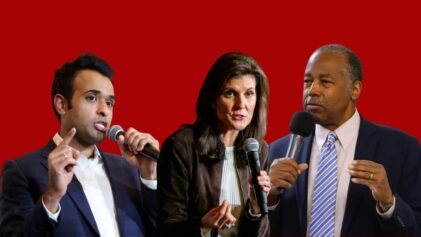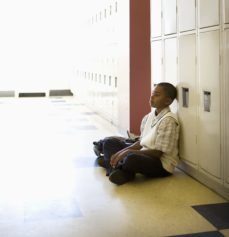
There are calls to fortify these institutions, in which Black young people are supported and loved. In a nurturing, healthy environment free of the garbage we see in majority-white academic institutions, young, gifted and Black minds can grow and secure their sense of self-worth. This is a way for Black young people to avoid the debilitating and crushing psychic damage that they will face at majority-white colleges, as has been the case for the years since Black students were first admitted.
The scope of the problem is clear. Black students at the University of Missouri, facing hate crimes, demand diversity reform at the University of Missouri, 46 years after their first, unmet set of demands. The university president and chancellor resign as a result. At Yale, Black students protest racial insensitivity from faculty and administrators, and call for the renaming of Calhoun College, named for a defender of slavery and hero of the Confederacy. Meanwhile, Princeton students stage a sit-in as the university considers eliminating the name of Woodrow Wilson—who supported the Ku Klux Klan and resegregated the federal government–from their buildings. And at Harvard Law School, a hate crime is committed as someone places tape over the pictures of Black professors on the wall. Who needs this?
Adrienne Green in The Atlantic poses the question as to whether Black colleges are the safe spaces Black students seek. “Many mainstream colleges, schools that enroll a majority of white students, have benefited from the diversity minority students provide—often creating a synthetic microcosm of the real world—but they appear less moved to ensure they serve as spaces that are inclusive for the students they work so hard to attract,” she notes.
HBCUs face challenges due to funding and resources, concerns over low graduation rates, and a perception of providing an inferior education–even from African-Americans. The endowments of all 105 HBCUs combined would only amount to 10 percent of Harvard’s endowment, which at $30 billion is the heftiest in the world, as USA Today reports. However, although HBCUs are merely 3 percent of the nation’s institutions of higher learning, they supply nearly 20 percent of Black students with undergraduate degrees, and 20 percent of Black students earning bachelor’s degrees in science and engineering. Further, more than 50 percent of Black professionals and public school teachers graduate from HBCUs.
Moreover, for all of their challenges, HBCUs produce graduates that fare better than their peers who attend other institutions. A recent Gallup poll of 56,000 college graduates found that 55 percent of Black HBCU alums say their college prepared them well for life after graduation, as opposed to 29 percent of non-HBCU college graduates. Further, HBCU grads are much more likely to say they benefited from encouraging professors and mentors, are more fulfilled and involved at work, and more are thriving financially (40 percent) than their non-HBCU peers (29 percent).
Green notes that these Black institutions provide not only cultural centers for students of color, but a community, from the students to the faculty, and a deeply entrenched support system that is concerned about the mental health of young Black people. “HBCUs allow students to unapologetically learn—without fear of violent criticism—about themselves as it pertains to their race,” she writes, while students of color at mainstream institutions are forced to navigate on their own, with no support from school officials and with hostility from white classmates. And as predominantly white universities drag their feet on the road to change, the prospects of an HBCU resurgence—free from the oppression of white supremacy– are increasingly relevant and demanding of our attention.
Predominantly white colleges and universities are facing pushback from Black students because they have offered diversity—sprinkling some dark faces around—while mistaking this for inclusion, a goal which requires more time and effort. Much has been written and reported on the benefits of diversity, and the ways in which diverse environments benefit the learning environment, particularly for white students, and foster more innovative workplaces. At the same time, diversity efforts face criticism as band-aid approaches that fail to address systemic racism.
Carla Shedd, an assistant professor of sociology and African-American studies at Columbia University argues in a new book that the school you attended shapes your attitudes about inequality. In Unequal City: Race, Schools, and Perceptions of Injustice, Shedd examines students at four Chicago public high schools to conclude that students at more racially diverse schools are more aware of racial injustice and inequality than those whose classmates look like them.
Further, study abroad programs, in which Blacks are underrepresented, offer many benefits to students’ well-being, as well as educational and economic benefits, and a heightened understanding of the world.
The benefits of diversity notwithstanding, the debate over HBCUs vs. predominantly-white institutions should not be viewed as an either-or, mutually exclusive proposition. Still, in order to wield power and gain security, the Black community must build its own prestigious institutions and solve its own problems. Those students fighting for change at Mizzou, Yale, Princeton and elsewhere must be applauded for doing the necessary work to reform these places. And yet, there needs to be an alternative for those who would rather not expend the psychological and physical energy necessary to fight to feel safe, only to emerge as a water carrier for white supremacy.
Now is the perfect opportunity to assist HBCUs in building their endowments, and supply them with the resources to create safe spaces to allow young people to thrive. During the Harlem Renaissance and the days of Black Wall Street, Black America protected itself and succeeded. If Black people want to exist successfully in America with white folks, we need to build our community. And if the HBCUs are not supported, they cannot improve and become what we want them to be.


